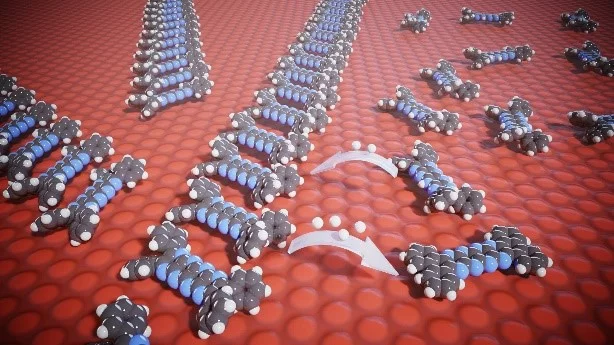The step-wise oxidation of a new redox-active molecular semiconductor is recognized by changing shape, assembly behavior and other properties by spectro-microscopy correlation.
Using X-ray photoelectron spectroscopy and scanning tunneling microscopy the oxidation of a set of Pyrazenacenes a newly synthesized redox active class of molecular semiconductors, has been investigated. The molecules comprise a very interesting case of multi-stage redox chemistry and photochemistry that has been investigated in solution and on surfaces. In addition to the oxidation state the molecular structure and conformation change with the redox reaction leading to specifically different self-assembled arrangement. In the native reduced form (obtained directly after synthesis), the molecules are isolated and immobile when deposited on a surface, while they mobilize to form chains after a first oxidation step. A second oxidation step changes the geometry of the molecule and they are again isolated and immobile.
Further information available
https://nanoscience.ch/en/2021/03/14/new-class-of-substances-for-redox-reactions/
D. Miklik et al. Communication Chemistry 4, 29 (2021) https://doi.org/10.1038/s42004-021-00470-w
Contact
Prof. Dr. Thomas Andreas Jung
Group Leader Molecular Nanoscience group
+41 56 310 45 18
thomas.jung@psi.ch
Original publication
Pyrazinacenes exhibit on-surface oxidation-state-dependent conformational and self-assembly behaviours
David Miklík, S. Fatemeh Mousavi, Zuzana Hloušková, Anna Middleton, Yoshitaka Matsushita, Jan Labuta, Aisha Ahsan, Luiza Buimaga-Iarinca, Paul A. Karr, Filip Bureš, Gary J. Richards, Pavel Švec, Toshiyuki Mori, Katsuhiko Ariga, Yutaka Wakayama, Cristian Morari, Francis D’Souza, Thomas A. Jung and Jonathan P. Hill Communication Chemistry 4, 29 (2021) https://doi.org/10.1038/s42004-021-00470-w


